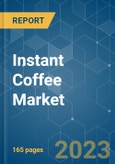Convenience is the foremost factor driving the demand for instant coffee that can be easily prepared. The increasing popularity of ready-to-eat products, especially among the working population and students, is another significant factor contributing to the market growth. Additionally, the wide availability of instant coffee, catering to different consumer tastes and preferences through various distribution channels, supports market expansion. Moreover, there is a growing focus on unique, authentic flavours and functional properties of coffee, leading to the premiumization of instant coffee. Both multinational players and local craft brands are emphasizing the creation of authentic flavours to meet diverse consumer demands. For example, in 2023, the Devon-based company Little’s introduced a new Toffee Nut Instant Coffee made from premium beans that are roasted and freeze-dried. The company also introduced instant coffee products in various flavours, including Rich Hazelnut, French Vanilla, spiced Cardamom Bun, and Christmas Spirit. These innovations, along with advancements in packaging such as sachets for single-use, are expected to further boost the sales of instant coffee products worldwide.
Instant Coffee Market Trends
Growing popularity of Flavored Instant Coffees
Flavoured instant coffees are increasingly becoming popular among consumers, as they offer a wide range of choices to consumers, from classic vanilla and hazelnut to seasonal flavours like pumpkin spice and peppermint. Flavoured instant coffee products, including pods, instant mixes, and pre-flavoured ground coffee, make it simple to prepare a beverage quickly, without needing syrups or additional ingredients. Further, the change in consumer preferences towards at-home coffee consumption or at-home brewing is driving the demand for flavoured instant coffees. Flavoured instant coffees allow consumers to recreate the experience of consuming a speciality drink in the comfort of their own home.Moreover, the availability of a wide range of speciality instant coffees in a variety of flavours like vanilla latte, cappuccino french vanilla and more from Nescafe, Folgers and others are driving the growth of flavoured instant coffee. Also, the rising health consciousness among consumers and the availability of a diverse range of flavoured coffees in sugar-free, low-calorie and fortified versions are boosting the demand for flavoured instant coffees.
Asia-Pacific Dominates the Market
Although tea is a traditional beverage in China, instant coffee is becoming popular among consumers due to changing consumer taste preferences. Moreover, instant coffee is easier to make, store, and consume than other counterparts available in the market. Therefore, it eventually increased the consumption of coffee in China. For instance, according to the International Coffee Association, overall coffee consumption in China grew by 14% from 2022 to 2023. Moreover, online retailing of instant coffee products has significantly impacted the market in India as emerging brands focus on marketing and retailing instant coffee in premium, flavoured, and artisanal blends through different distribution channels.Furthermore, the rising disposable income in the region and consumers with fast-paced lifestyles are more inclined towards instant coffee, as it offers easy and quick preparation. For Instance, in 2022, Japanese working households had an average monthly disposable income of 501 thousand yen (0.0041 USD Million), which is the highest of the decade and around 64% of it was used to cover living expenses, such as food and housing expenses.
Instant Coffee Industry Overview
The global instant coffee market is fragmented, with international and regional players competing for significant market share. Some key players include Nestlé SA, JM Smucker Company, JAB Holding Company, Starbucks Corporation, and Luigi Lavazza SpA. The major players are indulging in strategies, such as product launches, mergers and acquisitions, expansions, and partnerships, to establish a strong consumer base and esteemed position in the market. Additionally, companies are entering new markets through geographical expansion and product line expansion to enhance their offering and customer reach.Additional Benefits:
- The market estimate (ME) sheet in Excel format
- 3 months of analyst support
This product will be delivered within 2 business days.
Table of Contents
Companies Mentioned (Partial List)
A selection of companies mentioned in this report includes, but is not limited to:
- Nestlé SA
- Unilever PLC
- Starbucks Corporation
- Kraft Heinz Company
- Tata Consumer Products Limited
- Luigi Lavazza SpA
- The Coca-Cola Company
- Tchibo GmbH
- Strauss Group Limited
- JAB Holding Company








